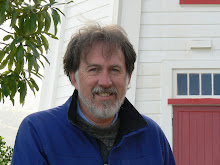 The Ultimate Threat to Human Health
The Ultimate Threat to Human HealthOne of my chief diversions after putting in a 10 hour day at the Otorohanga Medical Center is reading. At present, I’m sampling a collection of posthumous essays by Bruce Chatwin entitled What Am I Doing Here. Like everything he did and wrote in his all too brief career, these fragments pulsate with creative energy and mischievious unpredictability. When I saw the title of this book, for example, my conventional instincts wanted to place a question mark at the end of it. But of course that’s not how Chatwin operated and just like the way he lived, his book leaves you somehow dangling and unsettled with the grammatical and punctuation tease of its title.
Let’s suppose for a moment, though, that there was a question mark. What am I doing here? What first sparked my interest in this place? I’ll leave the personal and existential aside and talk about the very first time my curiosity about New Zealand was piqued. I can pinpoint the date precisely because New Zealand appeared on my radar when then Prime Minister David Lange had the audacity to stand up to the United States military and forbid the entry of U.S. Navy warships into New Zealand waters if they were powered by nuclear reactors or carrying nuclear weapons. Of course official US reaction and response to this request was to refuse to confirm or deny the nuclear status of any given US warship. There then unfolded a steady deterioration in relations between New Zealand and the US which culminated in New Zealand’s expulsion from the ANZUS alliance in the South Pacific. Shortly afterward, in 1985, French secret agents blew up the Greenpeace ship Rainbow Warrior in the Auckland Harbour because of its stated intention to monitor nuclear testing by France in the South Pacific. This has been, as historian Michael King put it, the first and only act of state-sponsored terrorism against New Zealand.
As a result of this dedicated antinuclear stance in an era characterized by increasing anxiety about the growing possibility of nuclear confrontation occurring between the United States and The Soviet Union, New Zealand was held in high esteem by those of us who refuse to believe that nuclear brinksmanship is a rational way to conduct foreign policy or promote the survival of the species.
A few years later in the early 90s while living in Beaufort South Carolina, I was asked to serve on a CDC citizens advisory committee on the health effects of the Savannah River Site, which is one of the two US Department of Energy /Department of Defense nuclear facilities built to produce plutonium, highly enriched uranium and the hydrogen isotope tritium. (The other is on the Columbia River in Hanford, Washington). I was pleasantly surprised to come to the conclusion that there was no credible evidence of increased cancer incidence in the immediate area surrounding the Savannah River nuclear facility. Based on several tours of the facility, however, I found it chilling to see the sinister artifacts of the Cold War like decommissioned, but still radioactive, reactors and nuclear waste from that time forward that has yet to be dealt with in any remotely definitive manner. Of course, the most logical approach of all to dealing with this deadly residue, often with a half-life calculated in thousands of years, is not to produce any more of it in the first place.The hubris behind the assumption that present levels of containment and monitoring will be feasible over such inconceivably long time frames is mind-boggling and betrays an almost delusional optimism that present political stability will persist ad infinitim.
There doesn’t seem to be much conversation about this issue anymore. But there are still enough nuclear weapons located at the Bangor nuclear submarine base in Keyport Washington, less than 10 miles from my home on Bainbridge Island, to end human history. The macabre local joke is that Kitsap County which encompasses both Bainbridge Island and Keyport, is the world’s third-largest nuclear power. Sometimes it just seems a little surreal to fuss over someone’s blood pressure or sprained ankle virtually in the shadow of weapons whose sole purpose is to vaporize human beings by the millions.
And speaking of millions, the replacement cost of the Ohio class nuclear submarine pictured above (taken from my sailboat this spring in Puget Sound as I was compliantly changing course) is estimated to be upwards of US$4 billion. There are a total of 18 such submarines and service in the U.S.Navy. 14 of which carry a up to 24 Trident submarine launched ballistic missiles each with up to 12 multiply targeted warheads, etc., etc. Quite aside from the sole purpose and mission of these weapons, the financial outlay is staggering. In a perfect world this would purchase a lot of healthcare. Maybe it’s just the burden of empire, but just maybe it’s also a failure of imagination that keeps us from envisioning a future that embraces an alternative to mutually assured destruction and putting our resources to better use to improve the future, not obliterate it.
So good on ya, New Zealand, for barring the grey metal boats from your waters. Maybe this memorable act of courage will inspire other countries to also take a stand against the ultimate cynicism that underlies these weapons of mass destruction---potentially the ultimate epidemic.


No comments:
Post a Comment